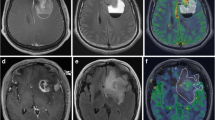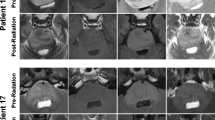Abstract
Introduction
In diffuse intrinsic pontine gliomas (DIPG), subtracting pre-contrast from post-contrast T1-weighted images (T1WI) occasionally reveals subtle, “occult” enhancement. We hypothesized that this represents intravascular enhancement related to angiogenesis and hence that these tumors should have greater blood volume fractions than do non-enhancing tumors.
Methods
We retrospectively screened MR images of 66 patients initially diagnosed with DIPG and analyzed pretreatment conventional and dynamic susceptibility contrast (DSC) perfusion MRI studies of 61 patients. To determine the incidence of occult enhancement, cerebral blood volume (CBV) values were compared in areas of occult enhancement (OcE), no enhancement (NE), and normal-appearing deep cerebellar white matter (DCWM).
Results
Tumors of 10 patients (16.4 %) had occult enhancement; those of 6 patients (9.8 %) had no enhancement at all. The average CBV in areas of occult enhancement was significantly higher than that in non-enhancing areas of the same tumor (P = .03), within DCWM in the same patient (P = .03), and when compared to anatomically paired/similar regions of interest (ROI) in patients with non-enhancing tumors (P = .005).
Conclusion
Areas of OcE correspond to areas of higher CBV in DIPG, which may be an MRI marker for angiogenesis, but larger scale studies may be needed to determine its potential relevance to grading by imaging, treatment stratification, biopsy guidance, and evaluation of response to targeted therapy.


Similar content being viewed by others
References
CBTRUS Central Brain Tumor Registry of the United States (2011) CBTRUS statistical report: primary brain and central nervous system tumors diagnosed in the United States 2004–2007, February
Hargrave D, Bartels U, Bouffet E (2006) Diffuse brainstem glioma in children: critical review of clinical trials. Lancet Oncol 7(3):241–248
Mantravadi RV, Phatak R, Bellur S, Liebner EJ, Haas R (1982) Brain stem gliomas: an autopsy study of 25 cases. Cancer 49(6):1294–1296
Yoshimura J, Onda K, Tanaka R, Takahashi H (2003) Clinicopathological study of diffuse type brainstem gliomas: analysis of 40 autopsy cases. Neurol Med Chir (Tokyo) 43(8):375–382, discussion 382
Roujeau T, Machado G, Garnett MR, Miquel C, Puget S, Geoerger B, Grill J, Boddaert N, Di Rocco F, Zerah M, Sainte-Rose C (2007) Stereotactic biopsy of diffuse pontine lesions in children. J Neurosurg 107(1 Suppl):1–4
Schumacher M, Schulte-Monting J, Stoeter P, Warmuth-Metz M, Solymosi L (2007) Magnetic resonance imaging compared with biopsy in the diagnosis of brainstem diseases of childhood: a multicenter review. J Neurosurg 106(2 Suppl):111–119
Leach PA, Estlin EJ, Coope DJ, Thorne JA, Kamaly-Asl ID (2008) Diffuse brainstem gliomas in children: should we or shouldn’t we biopsy? Br J Neurosurg 22(5):619–624
Hankinson TC, Campagna EJ, Foreman NK, Handler MH (2011) Interpretation of magnetic resonance images in diffuse intrinsic pontine glioma: a survey of pediatric neurosurgeons. J Neurosurg Pediatr 8(1):97–102
Law M, Yang S, Wang H, Babb JS, Johnson G, Cha S, Knopp EA, Zagzag D (2003) Glioma grading: sensitivity, specificity, and predictive values of perfusion MR imaging and proton MR spectroscopic imaging compared with conventional MR imaging. AJNR Am J Neuroradiol 24(10):1989–1998
Hargrave D, Chuang N, Bouffet E (2007) Conventional MRI cannot predict survival in childhood diffuse intrinsic pontine glioma. J Neurooncol 86(3):313–319
Poussaint TY, Kocak M, Vajapeyam S, Packer RI, Robertson RL, Geyer R, Haas-Kogan D, Pollack IF, Vezina G, Zimmerman R, Cha S, Patay Z, Boyett JM, Kun LE (2011) MRI as a central component of clinical trials analysis in brainstem glioma: a report from the Pediatric Brain Tumor Consortium (PBTC). Neuro Oncol 13(4):417–427
Rueckert DFA, Schnabel JA (2003) Automatic construction of 3-D statistical deformation models of the brain using nonrigid registration. IEEE Trans Med Imaging 22:1014–1025
Brat DJ, Van Meir EG (2004) Vaso-occlusive and prothrombotic mechanisms associated with tumor hypoxia, necrosis, and accelerated growth in glioblastoma. Lab Investig 84(4):397–405
Folkman J (1992) The role of angiogenesis in tumor growth. Semin Cancer Biol 3(2):65–71
Jain R, Gutierrez J, Narang J, Scarpace L, Schultz LR, Lemke N, Patel SC, Mikkelsen T, Rock JP (2010) In vivo correlation of tumor blood volume and permeability with histologic and molecular angiogenic markers in gliomas. Am J Neuroradiol 32(2):388–394
Scott JN, Brasher PM, Sevick RJ, Rewcastle NB, Forsyth PA (2002) How often are nonenhancing supratentorial gliomas malignant? A population study. Neurology 59(6):947–949
Rong Y, Durden DL, Van Meir EG, Brat DJ (2006) ‘Pseudopalisading’ necrosis in glioblastoma: a familiar morphologic feature that links vascular pathology, hypoxia, and angiogenesis. J Neuropathol Exp Neurol 65(6):529–539
Semenza GL (2007) Vasculogenesis, angiogenesis, and arteriogenesis: mechanisms of blood vessel formation and remodeling. J Cell Biochem 102(4):840–847
Kaur B, Khwaja FW, Severson EA, Matheny SL, Brat DJ, Van Meir EG (2005) Hypoxia and the hypoxia-inducible-factor pathway in glioma growth and angiogenesis. Neuro Oncol 7(2):134–153
Aronen HJ, Gazit IE, Louis DN, Buchbinder BR, Pardo FS, Weisskoff RM, Harsh GR, Cosgrove GR, Halpern EF, Hochberg FH et al (1994) Cerebral blood volume maps of gliomas: comparison with tumor grade and histologic findings. Radiology 191(1):41–51
Maia AC Jr, Malheiros SM, da Rocha AJ, da Silva CJ, Gabbai AA, Ferraz FA, Stavale JN (2005) MR cerebral blood volume maps correlated with vascular endothelial growth factor expression and tumor grade in nonenhancing gliomas. AJNR Am J Neuroradiol 26(4):777–783
Sadeghi N, D’Haene N, Decaestecker C, Levivier M, Metens T, Maris C, Wikler D, Baleriaux D, Salmon I, Goldman S (2008) Apparent diffusion coefficient and cerebral blood volume in brain gliomas: relation to tumor cell density and tumor microvessel density based on stereotactic biopsies. AJNR Am J Neuroradiol 29(3):476–482
Hu LS, Eschbacher JM, Dueck AC, Heiserman JE, Liu S, Karis JP, Smith KA, Shapiro WR, Pinnaduwage DS, Coons SW, Nakaji P, Debbins J, Feuerstein BG, Baxter LC (2011) Correlations between perfusion MR imaging cerebral blood volume, microvessel quantification, and clinical outcome using stereotactic analysis in recurrent high-grade glioma. Am J Neuroradiol 33(1):69–76
Ueoka DI, Nogueira J, Campos JC, Maranhao Filho P, Ferman S, Lima MA (2009) Brainstem gliomas–retrospective analysis of 86 patients. J Neurol Sci 281(1–2):20–23
Fischbein NJ, Prados MD, Wara W, Russo C, Edwards MS, Barkovich AJ (1996) Radiologic classification of brain stem tumors: correlation of magnetic resonance imaging appearance with clinical outcome. Pediatr Neurosurg 24(1):9–23
Hipp SJ, Steffen-Smith E, Hammoud D, Shih JH, Bent R, Warren KE (2011) Predicting outcome of children with diffuse intrinsic pontine gliomas using multiparametric imaging. Neuro Oncol 13(8):904–909
Paugh BS, Qu C, Jones C, Liu Z, Adamowicz-Brice M, Zhang J, Bax DA, Coyle B, Barrow J, Hargrave D, Lowe J, Gajjar A, Zhao W, Broniscer A, Ellison DW, Grundy RG, Baker SJ (2010) Integrated molecular genetic profiling of pediatric high-grade gliomas reveals key differences with the adult disease. J Clin Oncol 28(18):3061–3068
Broniscer A, Baker JN, Tagen M, Onar-Thomas A, Gilbertson RJ, Davidoff AM, Panandiker AP, Leung W, Chin TK, Stewart CF, Kocak M, Rowland C, Merchant TE, Kaste SC, Gajjar A (2010) Phase I study of vandetanib during and after radiotherapy in children with diffuse intrinsic pontine glioma. J Clin Oncol 28(31):4762–4768
Monje M, Mitra SS, Freret ME, Raveh TB, Kim J, Masek M, Attema JL, Li G, Haddix T, Edwards MS, Fisher PG, Weissman IL, Rowitch DH, Vogel H, Wong AJ, Beachy PA (2011) Hedgehog-responsive candidate cell of origin for diffuse intrinsic pontine glioma. Proc Natl Acad Sci U S A 108(11):4453–4458
Barrow J, Adamowicz-Brice M, Cartmill M, MacArthur D, Lowe J, Robson K, Brundler MA, Walker DA, Coyle B, Grundy R (2011) Homozygous loss of ADAM3A revealed by genome-wide analysis of pediatric high-grade glioma and diffuse intrinsic pontine gliomas. Neuro Oncol 13(2):212–222
Law M, Brodsky JE, Babb J, Rosenblum M, Miller DC, Zagzag D, Gruber ML, Johnson G (2007) High cerebral blood volume in human gliomas predicts deletion of chromosome 1p: preliminary results of molecular studies in gliomas with elevated perfusion. J Magn Reson Imaging 25(6):1113–1119
Lobel U, Sedlacik J, Reddick WE, Kocak M, Ji Q, Broniscer A, Hillenbrand CM, Patay Z (2011) Quantitative diffusion-weighted and dynamic susceptibility-weighted contrast-enhanced perfusion MR imaging analysis of T2 hypointense lesion components in pediatric diffuse intrinsic pontine glioma. AJNR Am J Neuroradiol 32(2):315–322
Lobel U, Sedlacik J, Sabin ND, Kocak M, Broniscer A, Hillenbrand CM, Patay Z (2010) Three-dimensional susceptibility-weighted imaging and two-dimensional T2*-weighted gradient-echo imaging of intratumoral hemorrhages in pediatric diffuse intrinsic pontine glioma. Neuroradiology 52(12):1167–1177
Barajas RF Jr, Hodgson JG, Chang JS, Vandenberg SR, Yeh RF, Parsa AT, McDermott MW, Berger MS, Dillon WP, Cha S (2010) Glioblastoma multiforme regional genetic and cellular expression patterns: influence on anatomic and physiologic MR imaging. Radiology 254(2):564–576
Acknowledgments
The authors thank Suzanne Gronemeyer, PhD, and the St. Jude Pediatric Oncology Education Program for supporting this work, Angela Edwards for post processing of some of the perfusion data and Cherise M. Guess, PhD, ELS, of St. Jude Children’s Research Hospital’s Scientific Editing Department for reviewing and editing the manuscript. This work was supported in part by Cancer Center Support (CORE) Grant (P30 CA21765) and 5R25CA02394 (to AEC) from the National Cancer Institute and the American Lebanese Syrian Associated Charities (ALSAC).
Conflict of interest
AB received partial financial support from AstraZeneca to conduct a clinical trial related to some of the patients included in the research described in this manuscript.
Author information
Authors and Affiliations
Corresponding author
Rights and permissions
About this article
Cite this article
Conway, A.E., Reddick, W.E., Li, Y. et al. “Occult” post-contrast signal enhancement in pediatric diffuse intrinsic pontine glioma is the MRI marker of angiogenesis?. Neuroradiology 56, 405–412 (2014). https://doi.org/10.1007/s00234-014-1348-9
Received:
Accepted:
Published:
Issue Date:
DOI: https://doi.org/10.1007/s00234-014-1348-9




